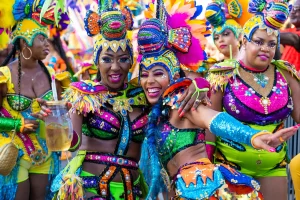
The rise of tourism and what it means for investment on Curacao
January 16, 2024
Schools for ALL
March 21, 2024There is nothing but excitement in the hot, sticky air. Cooling breezes carry the scents that revive your soul - fried snacks and beer. Your chest muscles and hips pulsate to the lively and loud Tumba rhythm. Spirits are high and there is an overwhelming sense of release and revelry. The spotlight is on the procession, of course, which is a visual assault of vivid, vibrant colors and sparkling lights amongst charismatic and contagious smiles. You can only be in one place: Nos Karnaval (Curaçao Carnival).

History, Masks and Myth
Historically, Carnival is a religious tradition that is celebrated in many Christian European and Latin countries. Curaçao is no exception and hosts one of the Caribbean’s largest and long standing Carnival celebrations. In 1901, festivities started in an elite and private club, which eventually took to the streets for the first time in 1947. Gaining in popularity over the years, in 1969, it was established as a series of events and better resembled how it is celebrated today. Now, enduring a month (or more), many Carnival events punctuate the main ceremonies of electing and crowning of Carnival royalty, the parades of the Gran Marcha (The Grand Parade) and Marcha Despedida (The Farewell Parade). Nos Karnaval also includes unique mini-festivals including the Tumba Festival. This is a four day affair where local musicians, composers and entertainers compete in hopes to have their Tumba (song) chosen as the official song of the Carnival year.
For the people of Curaçao, Nos Karnaval evolved out of appreciation for African ancestry within their Caribbean culture. People celebrate triumphantly to honor the emancipation of once enslaved people of the region. Music, masks and myth form an essential part of the Caribbean Carnival experience, all especially evident in Curaçao. Elaborate masks, costumes and make up form a symbolic type of ritual reversal which permits the breaking of life’s typical rules where inhibitions run free.

The Grand Finale
Carnival’s culminating figure is Rei Momo (King Momo) who is made of straw, wood, plaster and fireworks(!). With roots in Greek myth, Momus was the god of satire and mockery. In other words: a troublemaker and revel-rouser. As the symbol of debauchery, and essentially, the spirit of Nos Karnaval, during his annual brief reign, he grants excess and decadence amongst Carnival-goers. Encouraging drinking, eating, smoking, and seduction among other things.
Where there is debauchery, there is drama (and maybe a little danger). At midnight, following the Farewell Parade, Ash Wednesday begins which is the official start of Lent. This is a 40-day period of prayer, discipline and sacrifice. King Momo is burned, and with him, all the craziness, sin and excess that he represented and encouraged. Thankfully, this effigy burning has moved on from the Roman tradition of sacrificing the chosen king of festivities! Talk about a rough night!
More than a cultural experience
Carnival is big business for the musicians and bands, businesses, costume designers and makers, event promoters, sponsors and more that participate annually. It’s a busy time on the island, with increased visitors and many resorts are at capacity. If dancing, drinking and sending off King Momo in a fit of flames for a karmic clear out seems like your ticket to the eternal paradise, plan your trip well in advance. It really is the only way to put a ceremonial close to the chaotic Carnival season and start with that fresh slate, year after debauchery filled year. Bon Karnaval, indeed!


